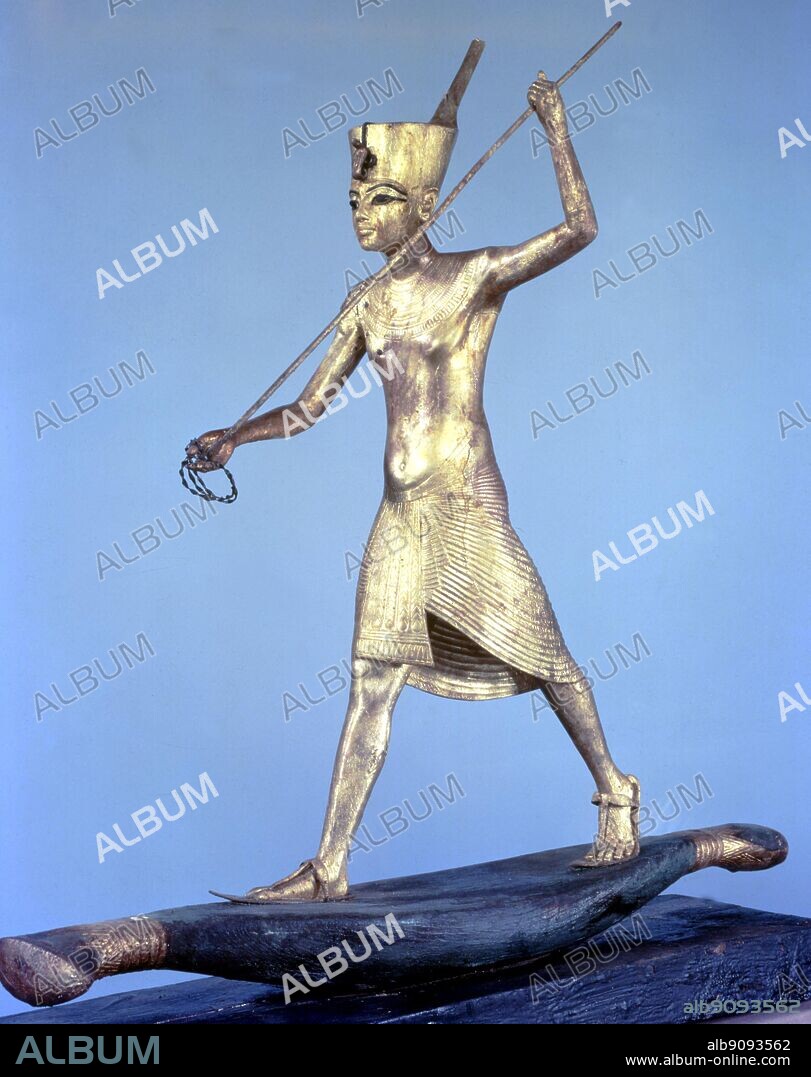alb9093562
Tutankhamen on a papyrus raft in the attitude of a harpooner. One of the funerarial objects used to evoke the mystical pilgrimages during the funeral. Gilded wood. Tukankhamen, by Christiane Desroches Noblecourt. . The Treasure Chamber in the tomb of Tutankhamun contained twenty-two black-painted wooden caskets, each of which contained one or more wooden statues portraying the pharaoh or a number of deities from the Egyptian pantheon. All of the figures contained in the black tabernacles are fixed to a rectangular base and at the moment of their discovery were wrapped in a linen cloth datable to the third year of the reign of Akhenaten. . Two twin statues in gilded wood depict Tutankhamun standing upright on a papyrus raft and engaged in a mythical hunt for the hippopotamus symbolizing evil. The pharaoh is represented as the incarnation of Horus, the god that according to the legend fought in the swamps against the evil Seth who was transformed into a hippopotamus and was finally defeated. . Tutankhamun, like the victorious god, has the task of fighting against evil and preserving the universal order of which he is the sole guarantor. The sovereign, seen in a striding pose taking a long, solemn step appears realistically to be concentrating on launching a long spear against his enemy. He is wearing the crown of Lower Egypt decorated at the front with a representation of the royal cobra above his youthful facial features.

|
Zu einem anderen Lightbox hinzufügen |
|
Zu einem anderen Lightbox hinzufügen |



Haben Sie bereits ein Konto? Anmelden
Sie haben kein Konto? Registrieren
Dieses Bild kaufen

Titel:
Tutankhamen on a papyrus raft in the attitude of a harpooner. One of the funerarial objects used to evoke the mystical pilgrimages during the funeral. Gilded wood. Tukankhamen, by Christiane Desroches Noblecourt. . The Treasure Chamber in the tomb of Tutankhamun contained twenty-two black-painted wooden caskets, each of which contained one or more wooden statues portraying the pharaoh or a number of deities from the Egyptian pantheon. All of the figures contained in the black tabernacles are fixed to a rectangular base and at the moment of their discovery were wrapped in a linen cloth datable to the third year of the reign of Akhenaten. . Two twin statues in gilded wood depict Tutankhamun standing upright on a papyrus raft and engaged in a mythical hunt for the hippopotamus symbolizing evil. The pharaoh is represented as the incarnation of Horus, the god that according to the legend fought in the swamps against the evil Seth who was transformed into a hippopotamus and was finally defeated. . Tutankhamun, like the victorious god, has the task of fighting against evil and preserving the universal order of which he is the sole guarantor. The sovereign, seen in a striding pose taking a long, solemn step appears realistically to be concentrating on launching a long spear against his enemy. He is wearing the crown of Lower Egypt decorated at the front with a representation of the royal cobra above his youthful facial features.
Untertitel:
Siehe automatische Übersetzung
Tutankhamen on a papyrus raft in the attitude of a harpooner. One of the funerarial objects used to evoke the mystical pilgrimages during the funeral. Gilded wood. Tukankhamen, by Christiane Desroches Noblecourt. The Treasure Chamber in the tomb of Tutankhamun contained twenty-two black-painted wooden caskets, each of which contained one or more wooden statues portraying the pharaoh or a number of deities from the Egyptian pantheon. All of the figures contained in the black tabernacles are fixed to a rectangular base and at the moment of their discovery were wrapped in a linen cloth datable to the third year of the reign of Akhenaten. Two twin statues in gilded wood depict Tutankhamun standing upright on a papyrus raft and engaged in a mythical hunt for the hippopotamus symbolizing evil. The pharaoh is represented as the incarnation of Horus, the god that according to the legend fought in the swamps against the evil Seth who was transformed into a hippopotamus and was finally defeated. Tutankhamun, like the victorious god, has the task of fighting against evil and preserving the universal order of which he is the sole guarantor. The sovereign, seen in a striding pose taking a long, solemn step appears realistically to be concentrating on launching a long spear against his enemy. He is wearing the crown of Lower Egypt decorated at the front with a representation of the royal cobra above his youthful facial features.
Bildnachweis:
Album / TopFoto
Freigaben (Releases):
Model: Nein - Eigentum: Nein
Rechtefragen?
Rechtefragen?
Bildgröße:
2699 x 3409 px | 26.3 MB
Druckgröße:
22.9 x 28.9 cm | 9.0 x 11.4 in (300 dpi)
Schlüsselwörter:
18. DYNASTIE • AEGYPTOLOGIE • CROWN • ENTDECKUNG • ERKUNDUNG • FLOSS (SCHIFFAHRT) • FLOSS • FLOSSER • HARPUNE • KOENIG • KÖNIG • KÖNIGE DER APOKALYPSE • MANN • NEUES REICH • SCHIFF: FLOSZ • STANDBILD • STATUE • ÄGYPTOLOGIE
 Pinterest
Pinterest Twitter
Twitter Facebook
Facebook Link kopieren
Link kopieren Email
Email
